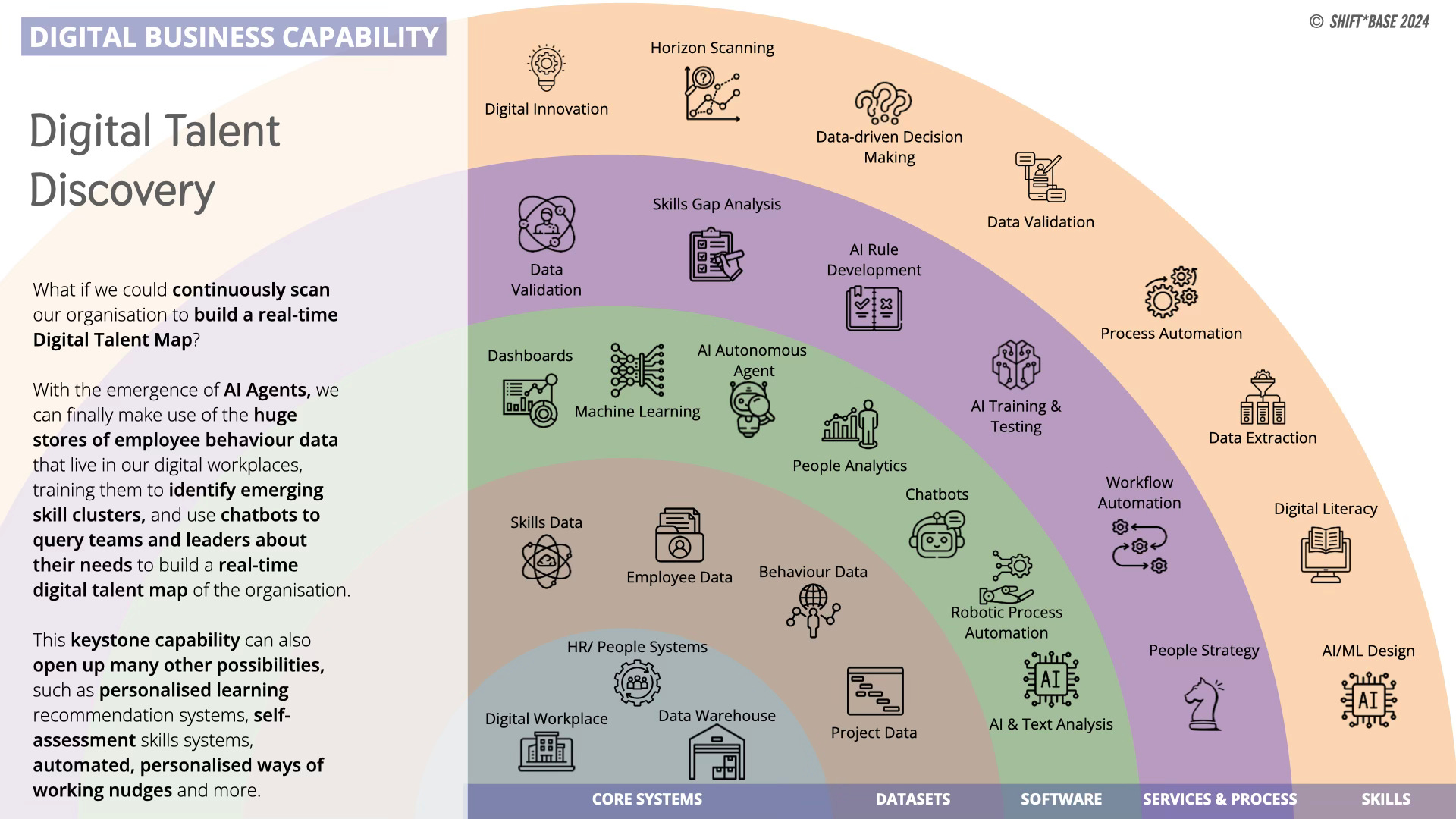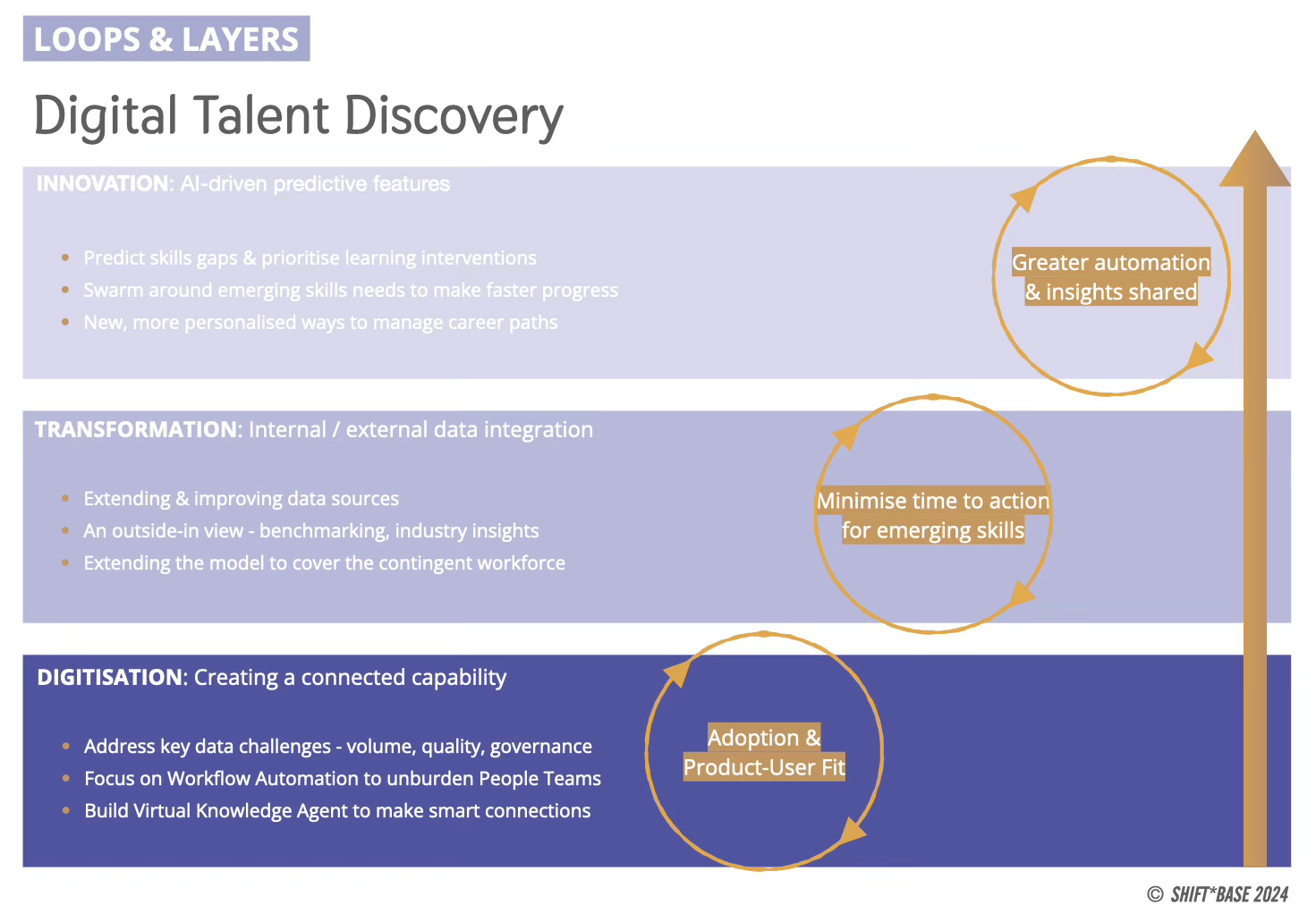Using a Capability Map to Design & Plan an AI Use Case for Digital Talent Discovery
The best use cases for AI in the enterprise will require integration with existing processes, but could enable entirely new ways of running them
Some of the most impactful use cases for AI in the enterprise involve integration with other processes and systems to create new ‘augmented’ digital business capabilities, and typically these need a multi-disciplinary approach and cross-functional collaboration.
In this edition, we will deep dive into one such use case - AI-enabled digital talent discovery - and share the model we use for sketching a capability, its dependencies and integration points with other systems and processes; plus, we will outline an approach we use to guide the capability’s evolution and improvement over time.
In developing the digital workplace, it helps to think of new business capabilities like apps or products, with an owner, an improvement roadmap and a clear value proposition for users. Mapping a new or existing capability in this way helps ensure all stakeholders are on the same page with a common view of what needs to be done.
(NB: you can click on the images and diagrams below for a full-screen view)
Creating an AI-enabled Digital Talent Discovery Capability
Most organisations still operate a talent and skills pipeline that changes too slowly to adapt to rapid shifts in technology, customer expectations and market conditions. Skills mapping and talent discovery are often rather generic, powered by formal skills profiles or CVs, and discovery of new or emerging competencies can therefore be limited.
If you want to know about the accountant who is automating financial analysis under their desk, the coder who is using generative personas to improve their app’s user experience, or the marketer who is a wizard at prompt whispering to generate more effective content, then the formal, rear-view-mirror approach of skills mapping may not be able to help you.
In addition to technical and enabling skills, we also want to identify transformational competencies - innovative ways of combining existing skills and behaviours - as these new hybrids will be more valuable in modern, connected organisations than over-specialising in a single skill silo.
A smarter approach to mapping and monitoring internal talent could also help uncover under-used capabilities and identify gaps, improve the link between skills development and strategy, and support more granular, personalised learning. It can also act as a keystone capability that enables other smart People and Talent features, such as:
Identifying roles at risk of high turnover and proactively addressing retention
Providing personalised career development and re-skilling recommendations for employees
Leveraging deeper data-driven insights to make more informed talent decisions
Empowering HR teams to focus on higher-value strategic work
Identifying Key Components
Every capability can be broken down into the ingredients needed - like a recipe. Breaking the big picture goal down into components can make it more actionable, but it also allows you to answer the following key questions:
What components are already have in place, and which are missing?
What related new technologies or initiatives are already planned?
What services - and therefore skills - need an upgrade or re-training?
Getting Started
Typically, HR or L&D might take the lead and provide a product owner, but it makes sense to involve other stakeholders and key functions in a guiding coalition, supported by IT and Operations, and the integration of specific components on the capability map can be assigned to the groups that own them.
As a stakeholder team, your first job is to assess organisational readiness to ensure the successful deployment and sustainability of this transformative talent capability. Organisational readiness encompasses the strategic alignment, technological infrastructure, data governance, and cultural preparedness required to effectively leverage AI in talent management. Without a comprehensive understanding of your current state of readiness, you risk encountering roadblocks, suboptimal outcomes, and potential ethical pitfalls that could undermine the project.
A new end-to-end capability, like Digital Talent Discovery, also requires a multi-disciplinary design team, including experts capable of advising or building the data model, algorithms, user interfaces, and integration with existing systems.
Designing Improvement Loops and Layers
As with other digital transformation initiatives, it can be helpful to think of a capability like this in terms of layers or stages of evolution and the improvement loops or fitness functions that you pursue as part of a continuous improvement strategy.






